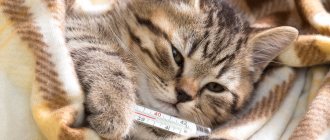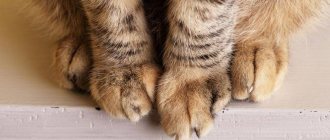Distemper in cats - routes of infection
Distemper in cats is a highly contagious disease. Routes of transmission of panleukopenia:
- Direct contact. A pet becomes infected through direct contact with objects that sick animals have interacted with. Feline distemper is not dangerous to humans. But people can bring the virus into the house on outerwear and outdoor shoes.
- Oral route. A cat can become infected with distemper by eating contaminated food or drinking.
- Airborne path. The feline distemper virus is transmitted from a sick animal to a healthy one when in the same room.
- Through parasites. The feline distemper virus can be transmitted through the saliva of blood-sucking insects.
- Intrauterine path. A kitten can become infected with distemper before birth. This happens when a pregnant cat passes the disease to her unborn babies, and often leads to the death of the fetuses.
On a note. A cat cannot catch distemper from a dog. Cat and canine distemper develop under the influence of different pathogens that differ in DNA structure and antigenic properties. Therefore, a puppy cannot become infected from a cat and vice versa.
Can other animals or humans become infected with feline distemper?
Is a pet with panleukopenia dangerous to others? Cats after distemper are carriers of the virus for 4-5 months and can become its source, but only a feline can become infected. The mustachioed friend poses no danger to surrounding people and pets.
The virus, which is carried by a recovered cat, is released into the external environment with biological fluids, so throughout the entire period of carriage the pet should not be allowed to leave the house. The cat itself acquires immunity to the plague for a long period, sometimes until the end of its life.
Mechanism of disease development
The incubation period for distemper in cats lasts 3-10 days. The virus provokes a decrease in the level of white blood cells and the production of a toxin that enters the organs and destroys them.
First, the pathogen penetrates the small intestine, bone marrow and lymphatic system. In a fairly short period of time, it affects the entire body of the animal, including the heart muscle, lungs and respiratory tract. As a result, the cat develops primary manifestations of the disease.
Distemper in cats - clinical symptoms
Depending on the characteristics of the course, panleukopenia can be fulminant, acute and subacute. Signs of distemper in cats depend on the form of the disease:
- Lightning form. It is especially dangerous for kittens and young animals under 1 year of age. It develops very quickly and has symptoms similar to rabies. Often the animal dies before all signs of the disease have time to appear. The fulminant form of distemper in cats is accompanied by lethargy, apathy, trembling of the limbs, decreased motor activity, sticking of fur, weak squeaking, and refusal of water and food. When the nervous system is damaged, the above symptoms are supplemented by fear of light and sound. After a short period of time, cats begin vomiting yellow foam and foul-smelling diarrhea, sometimes mixed with blood.
- Acute form. Usually affects adult animals and has a short incubation period, lasting 24-48 hours. Distemper manifests itself in acute form with symptoms such as decreased motor activity, yellow or green vomiting with blood, light-colored loose stools, pain in the peritoneum, hyperthermia, increased lacrimation, prolapse of the third eyelid, refusal of water, lack of appetite, conjunctivitis, rhinitis, rapid heartbeat, swelling of the larynx, inflammation of the lymph nodes, hoarse breathing and frequent coughing.
- Subacute form. It affects cats with strong immunity and is characterized by an extended incubation period of 1-3 weeks. The subacute form of distemper in cats proceeds in the same way as the acute form, but has less pronounced symptoms.
Establishing diagnosis
Panleukopenia is a very dangerous disease, so the main thing to do when the first symptoms appear is to show the animal to a veterinarian. To make a diagnosis, attending physicians first examine and listen to four-legged patients, and then ask the owners about when the first symptoms of distemper appeared in cats.
After analyzing the data obtained, the animals are prescribed a set of studies.
Diagnostic methods
To understand whether a cat has the causative agent of panleukopenia in its body, blood and feces are taken from it for examination. To detect the virus, the following diagnostic methods are used:
- clinical blood test;
- examination of feces using the PCR method;
- blood chemistry;
- Ultrasound of the abdominal cavity;
- smear of discharge from the eye.
On a note. PCR testing may give a positive result in recently vaccinated animals. Therefore, be sure to check how long ago the cat was vaccinated.
Differential diagnoses
For effective treatment of distemper in cats, it is important to make a correct diagnosis. Since panleukopenia has symptoms characteristic of many diseases, the first step is to exclude:
- feline immunodeficiency virus;
- acute toxoplasmosis;
- intestinal perforation;
- pancreatitis;
- intoxication of the body;
- leukemia.
What can panleukopenia be confused with?
Firstly, with poisoning. An important difference between panleukopenia and poisoning is that with this disease, at the initial stage of the disease, the animal’s body temperature rises significantly, up to 40-41 degrees and above. In case of poisoning, the temperature is normal or low. However, kittens quickly enter the second phase of the disease - exhaustion of the body, during which the temperature drops. In this case, only a veterinarian can distinguish between these two conditions.
Secondly, with acute toxoplasmosis. Most often, this infection is carried by cats asymptomatically, but in kittens it is difficult to distinguish between these two infections by symptoms. This is where express analysis or PCR comes to the rescue. Toxoplasmosis in kittens, although severe, is less dangerous than panleukopenia. There is a specific treatment for this disease, that is, drugs that kill the pathogen.
Thirdly, with pancreatitis, acute gastroenteritis of non-viral nature and other diseases of the gastrointestinal tract. With these diseases, the temperature may rise, but the pathogen will not be identified, and in small kittens they are all quite rare.
Treatment and prognosis
Distemper in cats must be treated comprehensively using etiotropic agents to destroy the virus and drugs that relieve the main symptoms. Typically, to treat panleukopenia, animals are prescribed the following drugs:
- Fosprenil. An antiviral drug is used to destroy pathogens and is administered intramuscularly for 14 days. In the early stages of the disease, it is used daily 4 times a day in a dosage of 0.2 ml of solution for kittens weighing up to 1 kg and 0.5 ml for cats weighing 1-5 kg. Gradually the number of injections is reduced to 1 time per day.
- Ringer, Regidron. Rehydrating drugs to eliminate signs of dehydration and normalize electrolyte balance. They are diluted with glucose and given to cats at the rate of 50 ml per 1 kg of weight.
- No-shpa, Dibazol. Painkillers that effectively relieve pain and relieve spasms. Used in the form of injections in strict accordance with the instructions of the veterinarian.
- Ticarcillin, Cephalosporin, Ampicillin. Antibiotics that destroy secondary bacterial infections. Used in injections strictly as prescribed by a doctor.
- Metaclopromide, Ondanseron, Maropitant are antiemetics. They are used in the form of injections strictly as prescribed by a veterinarian.
- Catozal. The metabolic stimulant normalizes metabolism and is used only on the recommendation of a specialist.
In addition to medications, treating a cat at home should include the use of iron-containing medications and vitamin complexes that contain folic acid.
Important! Although experts strongly discourage treating cats with vodka, there are cases where animals survived after such therapy. True, it cannot be said that the reason for the recovery was the use of alcohol, and not the strong immunity of the pets.
To speed up the healing process, the animal needs to be provided with proper care:
- Disinfecting surfaces using an ultraviolet lamp and sodium hypochlorite solution. The area where the sick cat is located should be disinfected. The animal's bedding and bowls should be disinfected with a soda solution prepared in a ratio of 1:20.
- Creating a favorable atmosphere. A cat suffering from distemper needs complete peace and positive emotions.
- Avoid contact with other animals. Distemper in cats is transmitted very quickly. Therefore, an infected pet is protected from contact with healthy companions.
- Maintaining cleanliness. All feces from a sick animal must be removed immediately. It is recommended that the room where the infected cat is kept is regularly ventilated and wet cleaned.
- Periodic eye cleansing. To do this, it is recommended to use clean gauze moistened with a special solution.
- Dieting. While the cat continues to be sick, she needs a special menu with low carbohydrate content and increased protein. To do this, it is recommended to introduce low-fat fermented milk products, boiled fish and beef into the animal’s diet.
Panleukopenia is characterized by high mortality. According to statistics, in 92% of cases it ends in the death of animals. Distemper is especially dangerous in kittens, with mortality rates reaching almost 100%.
Disease prevention
The only effective method of preventing distemper in cats is timely vaccination with drugs such as Nobivak or Multifel. The first vaccination for kittens is given at the age of 1.5-2 months with a mandatory repetition after 3 weeks. Subsequently, cats are vaccinated once a year.
Also, to prevent infection with distemper, you should not let unvaccinated pets outside and prevent them from coming into contact with other people’s animals.
Distemper in cats is a very dangerous and contagious disease, often leading to death. And even if it is possible to save the animal, it may still have serious consequences in the form of chronic pathologies of the nervous, respiratory and cardiovascular systems.











